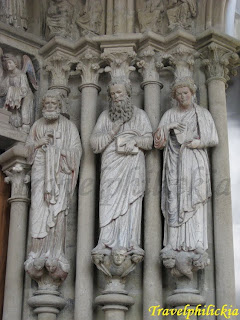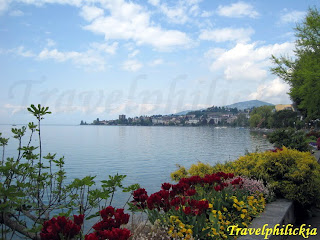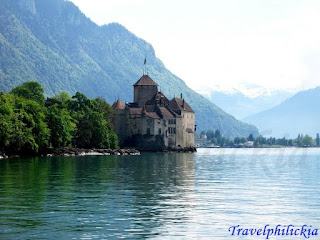Lausanne
Lausanne is a city in Romandy, the French-speaking part of Switzerland, and is the capital of the canton of Vaud.
Took up a SBB promotion fare at CHF 35.60 which includes return train rides (2nd class) from/back to Neuchatel, return trips on Metro trains to/from Ouchy and admission to Olympic Museum.
Lausanne Transport System
Reached the Lausanne railway station at about 1030 am. This railway station is typically the same as other stations in Switzerland (left photo below), except the huge letters in front of the main entrance that emphasized Lausanne is the Capitale Olympique - The Olympic Capital (right photo below).


Speaking about its transport system, Lausanne holds a world record; it is the smallest city to have full metro system. Its M2 line is fully automated (left photo below) with comfortable seats and well-lit train cabin (right photo below). Each train ride cost CHF 1.90 without concession.


Olympic Museum
Took the metro train from Lausanne-Gare (station opposite the main railway station) to Ouchy (last station of Line M2). The whole train ride took only less than 5-mins. After which, another 5-mins is required to walk to the Olympic Museum from the metro station.
Lausanne is where the headquarters of International Olympics Committee (IOC) is located. Therefore it is not surprising that the largest museum of Olympic themes is located there (left photo below). Founded on 23 Jun 1993, this Olympic Museum houses more than 10,000 pieces of Olympic-related objects and drawing more than 250,000 visitors a year to Lausanne.
Visitors are first greeted by flags of the Olympic, Switzerland and Vaud Canton flying in front of the fountain (right photo below).


A small park is located before the Museum where sculptures of various sporting themes are displayed (photos below).


Museum entrance is decorated with few columns (left photo below), each marked with the hosting countries of Summer / Winter Olympic Games, as well as Paralympics. My guess is a new column for inaugural Youth Olympic Games (YOG) will be erected sometime in Aug 2010. By then, the name of the first hosting country: Singapore will definitely be engraved onto this column. Another symbolic structure is the burning Olympic flame (right photo below) not far from the main entrance.


After showing the train promotional ticket to the friendly counter staffs (left photo below) for the entrance tickets, I asked one of them out-of curiosity if there's any exhibition on the YOG. Initially can't understand what I meant (since their official language is French), but after confirming from the logo on her security pass, she replied that it's still early in April and the museum has only began to set up the exhibition. Rather disappointed, we told her that we are Singaporean and "came all the way" to see this exhibition. Probably not to let us down, she went inside the counter and took out some YOG badges and gave one to each of us (right photo below). Perhaps this "cheap-thrill" make us feel we were the first few Singaporeans to get souvenirs related to YOG.


The permanent exhibit on the ground floor present the historical artifacts from the beginning (left photo below), then to the present day Olympic events and its committee (right photo below). Among the many exhibits, what I liked is the display of Olympic torches from various hosting nations. Before seeing, I didn't know that so many details had been put on the design of these torches. On the first floor, great moments of the Olympics can be felt from the displays of sports attire and equipments of athletes (bottom photos), as well as from the audio-visual productions and 3D films.




The main exhibits of the museum are located on the ground and 1st floor, and accessible using the spiral stairs in the middle of building (left photo below). Besides restaurants at the 2nd floor, there is a Souvenir Shop (right photo below) located at the ground floor. Opening hours of the museum is daily from 0900 to 1800 hours (but closed on Mondays from 1 Nov till 31 Mar). Nearest Metro Station is M2 Ouchy.


Ouchy Waterfront
Used to be a fishing village, Ouchy has now become a popular lakeside resort in Lausanne (left photo below). Swans could be seen any time of the day waiting for food from visitors (right photo below).


Cruises on the lake depart from the harbor daily and can be easily spotted by the iconic 'Big-C' structure (photos below). Boats can be taken at this harbor to the famous mineral water manufacturer 'Evian' located at the French border opposite the lake.


There is a 12th century castle that once defended the harbor which now forms part of the Neo-Gothic Château d'Ouchy, built in the 1890s. This castle is now a hotel and restaurant (left photo below). There is another hotel d'Angleterre (right photo below), where Lord Byron stayed when he came to Lausanne and where he wrote the book The Prisoner of Chillon.


Lausanne City Centre
Took the metro from Ouchy back to the City Centre. This city is set on three hills that rise in tiers from the lakeshore. Thus most of the streets are in steep gradients (photos below), and much efforts are required to explore this city centre.


Among the many shops, my colleague recommended this Ladurée macaroon shop (left photo below) located along Rue du Bourg. Tried one of those macaroons and must comment that these small cakes are much crispy and has smoother cream compared to other macaroons I've tasted (right photo below). However the price of these macaroons is not cheap; each macaroon can cost about CHF 1.50 together with the nice packaging.


Lausanne Cathedral
Begun construction in mid-12th century and completed in 13th century, the Lausanne Cathedral (also known as Cathédrale Notre-Dame in French) is the finest Gothic building in Switzerland (left photo below). It is built on the site of a Roman camp and overlies the foundations of Carolingian and Romanesque basilicas. With a central nave flanked by aisles, a transept over which rises a tower (right photo below), an apse and an ambulatory, the cathedral's design and decoration show the influence of the French Gothic style.


The top of the southwest tower commands a spectacular view of the city and Lake Geneva. As the weather was good, we decided to climb up this tower to view the nice surroundings. Paid CHF 2 at a souvenir shop and started walking up the spiral stairs (left photo below) and finally took about 5-mins to reach the top (right photo below). View of Lausanne city is indeed impressive with sights as far as buildings near Lake Geneva (bottom photos).




Alternating thick and slender columns line the nave (left photo below). These thick columns also support the central vaulting (right photo below). Stained glass windows is another not-to-miss feature (bottom left photo), especially the rose window (bottom right photo) on the south arm. The rose window is among the few masterpieces of European artistic heritage where it depicts the medieval view of the world arranged around the figure of God creator.




One significant feature of the cathedral is its multi-colored interior, where the paintings as well as on the statues of the painted doorway (photos below) on the North side. This is unique in all Europe. The entrance at the west end, known as the Montfalcon Portal, is decorated with replicas of Gothic carvings (bottom photos) dating from year 1515 – 1536.




Place de la Palud
Located in the central of Lausanne's Old Town, Place de la Palud is a popular meeting area, and street market takes place there on Wednesday and Saturdays. At the centre of the square is a 16th – 18th century Fontaine de la Justice, with an allegorical figure of Justice (left photo below). Not far from the fountain is a mechanical clock (right photo below) that has hourly show of some historical events.


Click on the video below to view the mechanical animations. Interestingly the mechanical clock was made by the famous watch manufacturer: Omega, while the narration was in French.
Montreux
Montreux is a municipality in the district of Riviera-Pays-d'Enhaut in the canton of Vaud in Switzerland.
Took train from Neuchatel to Lausanne which cost CHF 12.50 per single trip. The purpose was to meet some friends at Lausanne and explore the Lausanne Carnival. However the carnival was rather disappointed, thus we took a single train ride (cost another CHF 5.10) to Montreux.
Montreux train station (left photo below) is a simple building with a visitor centre and a small supermarket. Beside the train station is row of classic buildings including hotels (right photo below) and restaurants along the waterfront.


Montreux is an upmarket resort that is renowned for its annual jazz festival. In the 19th century, its charm captivated many artists, writers and musicians, including Lord Byron and Mary Shellery, Leo Tolstoy and Hans Christian Anderson. The metal-framed market hall (left photo below) was built in 1890 using funds donated by Henri Nestlé, founder of the powdered milk company. At the end of the lakeshore is a bronze statue of Freddie Mercury – 1946 to 1991 (right photo below), a vocalist in the band Queen. Don't know who he is? Initially I also don't know who he was until my colleague sang his famous song "We will… we will… ROCK you!" (Song title: We Will Rock You).


As the weather was fine, we decided to walk to Chillon Castle instead of taking the cruise. Lakeshore along the path is decorated with blooming flowers, and together with the scenery in the background, do make an excellent photographic spot. With the beautiful setting on Lake Geneva, great view of the French Alps could be seen at the opposite side on a clear day (photos below).




Probably it was part of the theme floral decorations; figures made using dried straws depict the cartoon characters from the movie Madagascar (photos below).


Took about half-an hour to stroll from Montreux train station to our next destination: Chillon Castle.
Chillon Castle
Also known as Château de Chillon in French, this enchanting medieval castle is set on a rocky spur on the eastern shore of Lake Geneva (left photo below). Chillon Castle (西庸堡) is one of Switzerland's most evocative sights with the magnificent mountains in the background. Built for the Dukes of Savoy, its origins probably go back to 11th century but its present appearance dates from the 13th century (right photo below). In 1536, the castle was captured by the Bernese, and from then until 1798 it was the seat of the region's Bernese bailiffs.


The interior of the castle is mainly constructed using bricks, tiles and wood. Timber wood is used as supporting structures for the roofs and corridors (photos below). Though most of the structures are for functional purposes, occasionally decorative structures such as on the windows (bottom left photo) can be found.




The castle's vaulted underground chambers (top right photo) were once used as a prison. Paintings drawn by prisoners could still be seen on the walls of these chambers (left photo below). François de Bonivard, who spent 6 years in captivity there, was immortalized by Lord Byron in The Prisoner of Chillon, a poem that he wrote in Ouchy in 1816. Evident of Lord Byron being imprisoned there can be seen from his name that was engraved onto the wall by himself (right photo below).


The Grand Burgrave Hall (left photo below) has a wooden ceiling resting on columns that supports the arches. The walls are also richly decorated with paintings (right photo below). Almost had an illusion that I was in the movie setting of Lord of the Rings, surrounded by medieval furniture. In a former banqueting hall, Aula Nova, contains a museum that displays the chests used by its former owners (bottom left photo). The recently restored wooden ceiling in this hall is also one of the highlights in this castle where all the decorations were hand-painted (bottom right photo).




The ceremonial hall, Heraldic Hall, displays the armor and weapons used (left photo below). In this hall, the coats of arms of the Bernese bailiffs can be found (right photo below).


Walls of the bed chambers are covered with paintings of various animals (left photo below), while the chapel contains portraits of holy saints (right photo below). Sadly most of these paintings are fading over time.


Admission to the Chillon Castle cost CHF 12 and rental of ipod audio guide is also available at additional CHF 6. Depending on the season, opening hour of the castle from 1000 to 1600 hours (Jan-Feb & Nov-Dec) or 0930 to 1700 hours (Mar-Oct), or 0900 to 1800 hours (Apr-Sep). Do note that the castle is closed on 01 Jan and 25 Dec.
Lake Geneva Cruise
As we wanted experience something different, thus decided to take a cruise ride from Chillon to Lausanne (Ouchy) along Lake Geneva (or Lac Léman in French). Bought our tickets at CHF 12.60 for 2nd class, which is almost the same price as the train tickets. The tickets consists of 2 cruise rides; first ride from Chillon to Montreux and the second ride from Montreux to Lausanne.
The Chillon jetty is just 100-meters walk from the main entrance of the castle (left photo below), definitely convenient to most visitors. The boat has an indoor and outdoor deck available (right photo below) and since the operator is a French company, French flags can be seen flying in front of the boat.


Only from the cruise that the rear view of the Chillon Castle could be seen (left photo below). The splendid Alps surrounding Lake Geneva could also be seen (right photo below) from this ride.


Jetty and the boat at Montreux are obviously bigger compared the one I took earlier (left photo below). The open deck is able to accommodate more passengers (right photo below). The cruise passes several cities along the shore of Lake Geneva such as Vevey (bottom left photo), and not to forget the magnificent French Alps on the opposite side of the lake (bottom right photo).




Lavaux
The highlight of the cruise is the view of Lavaux. Lavaux consists of 830 hectares of terraced vineyards that stretch for about 30-km along the south-facing northern shores of Lake Geneva. It is where vines are grown since Roman times, and some of the actual vine terrace could trace back to the 11th century.
 |
Lavaux has been listed as UNESCO World Heritage Sites since July 2007. |




The cruise ride ended at Lausanne (Ouchy). After which we took the Metro train back to the Gare (Main Railway Station) and bought our rail tickets at CHF 12.50 for single trip back to Neuchâtel.
 Posts RSS
Posts RSS


